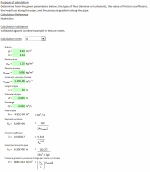Analysis of pipe flow.xls

Description
Purpose of calculation: Determine from the given parameters below, the type of flow (laminar or turbulent), the value of friction coefficient, the head loss along the pipe, and the pressure gradient along the pipe.
Calculation Validation: Validated against worked example in lecture notes.
Calculation Reference
Hydraulics
Fluid Mechanics
To determine the type of flow (laminar or turbulent), friction coefficient, head loss, and pressure gradient along a pipe, you need to follow these steps:
- Calculate the Reynolds number (Re): Re = (ρ * v * D) / μ
where:
- ρ = fluid density (kg/m³)
- v = fluid velocity (m/s)
- D = pipe diameter (m)
- μ = dynamic viscosity (Pa·s)
-
Determine the type of flow: If Re 4000, the flow is turbulent. If 2000 Re 4000, the flow is in a transition zone.
-
Calculate the friction factor (f): For laminar flow (Re 2000), use the Hagen-Poiseuille equation: f = 16 / Re
For turbulent flow (Re > 4000), use the Moody chart or an approximation formula, like the Colebrook-White equation, which requires an iterative method to solve: 1 / √f = -2 * log10[(ε/D) / 3.7 + 2.51 / (Re * √f)]
where:
- ε = pipe roughness (m)
- D = pipe diameter (m)
- Calculate the head loss (h_L) using the Darcy-Weisbach equation: h_L = (f * L * v²) / (2 * g * D)
where:
- f = friction factor
- L = pipe length (m)
- v = fluid velocity (m/s)
- g = acceleration due to gravity (approximately 9.81 m/s²)
- D = pipe diameter (m)
- Calculate the pressure gradient (ΔP/L) along the pipe: ΔP/L = ρ * g * h_L / L
where:
- ρ = fluid density (kg/m³)
- g = acceleration due to gravity (approximately 9.81 m/s²)
- h_L = head loss (m)
- L = pipe length (m)
By following these steps, you can determine the type of flow, friction factor, head loss, and pressure gradient along a pipe. These calculations are essential for designing and analyzing fluid transport systems, such as water distribution networks, HVAC systems, or industrial processes.
Calculation Preview
Full download access to any calculation is available to users with a paid or awarded subscription (XLC Pro).
Subscriptions are free to contributors to the site, alternatively they can be purchased.
Click here for information on subscriptions.

